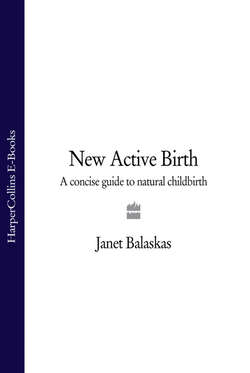Читать книгу New Active Birth: A Concise Guide to Natural Childbirth - Janet Balaskas - Страница 19
Why is Active Birth Better?
ОглавлениеWhat explains the fact that women have easier labours and births when they move about and assume upright positions?
Common sense and recent studies suggest that, in upright positions, these are the advantages to mother and baby:
1 The pull of gravity, i.e. the earth’s downward gravitational force, assists uterine contractions and bearing down efforts. It is easier for any object to fall towards the earth’s surface than to slide parallel to it (Newton’s Law of Gravity), so that it is mechanically more advantageous to expel an unborn baby towards the earth than to expel it along the horizon. In upright positions such as standing, squatting or kneeling, the mother’s body is in harmony with the downward force of gravity. When she lies down her involuntary efforts to expel the baby spontaneously are inhibited, increasing the need for strenuous effort to push the baby ‘uphill’ or the need for a forceps extraction. Dr Peter Dunn, Consultant Senior Lecturer in Child Health at Southmead Hospital in Bristol, writing on the recumbent position for labour in The Lancetin 1976, noted, ‘No animal species adopts such a disadvantageous posture during such an important and critical event’ (25).
2 The drive angle of the uterus, i.e. the angle between the long axis of the unborn baby’s spinal column and that of the mother’s spinal column, is less when upright, so demanding less effort from the uterus. The uterus tilts forward when it contracts. In an upright position where the mother can lean forward, she is assisting her uterus to work with least resistance whereas, if she is lying down or leaning back, the uterus has to work harder against the downward force of gravity (see here). A muscle working against gravity tends to tire and ache more easily so leaning forward is an efficient way to reduce pain and the need for analgesics.
3 In between contractions, the increased pressure of the abdominal wall, the diaphragm and the baby’s head all in turn increase the pressure on the cervix during the resting phase.
4 The entrance of the baby’s head, or presenting part, to the inlet of the mother’s pelvis is easier and the head’s direct application to the mother’s cervix is assisted, because the pelvic inlet points forward and the outlet faces downward, producing a convenient angle of descent. With each contraction of the uterus the unborn baby has a tendency to sink towards the mother’s cervix.
5 There is improved placental circulation giving better oxygen supply to the foetus. Lying down on one’s back is the one position that causes compression of the major abdominal blood vessels along the spinal column. Compression of the large artery of the heart (descending aorta) can cause foetal distress by hindering blood circulation around the uterus and the placenta. Compression of the large veins leading to the heart (inferior vena cava) blocks the returning blood flow, contributing to hypotension and the possibility of maternal haemorrhage.
6 There is less pressure on the pelvic nerves stemming from the lower part of the spine and sacrum, and less resistance to the uterine effort, therefore there is less pain.
7 During pregnancy the flexibility of the pelvic joints is increased by hormones that soften the ligaments that hold them together. In upright positions, the pelvic joints are free to expand, move and adjust to the shape of the descending head of the baby during labour and birth. When the sacrum is free to move, the pelvic outlet can widen by as much as 30 per cent more (i.e. in the squatting position) than when the mother’s weight is resting directly on it and preventing any movement (i.e. semi-reclining). The sacro-coccygeal joint, i.e. the joint between the sacrum and the coccyx or tailbone, also softens and is designed to swivel backwards to widen the outlet of the pelvis as the baby emerges. Of course, this is impossible if the mother is sitting on her coccyx (i.e. semi-sitting position).
8 When the mother is upright there is less direct pressure on the baby’s neck vertebrae as the head passes under the pubic arch and the neck extends backwards during the second stage (see diagram here). Although no studies have yet been done, it is easy to observe how actively-born babies have better head control immediately after birth. This facilitates the ‘rooting reflex’ for breastfeeding and also enhances motor development after birth.
9 Upright positions facilitate the successful and spontaneous separation of the placenta and reduce the need for controlled cord traction and the risk of post-partum infection or haemorrhage (26).
10 There is less likelihood of infection as fluids can drain more easily when the mother is upright and ‘pooling’ does not occur.
11 In an upright position, the perineal tissues can expand evenly and pull back around the baby’s head, emerging at birth, and the risk of tearing is reduced. In the semi-reclining or semi-sitting position the baby’s head descends forward directly onto the perineum which is immobilised and cannot expand. This situation is worsened if the mother is in the lithotomy position with her legs in stirrups. This separates the legs to a much great extent than usual and actually stretches the perineal tissues, increasing the need for episiotomy. In an active birth episiotomy is rarely necessary and is usually only done in an emergency.
